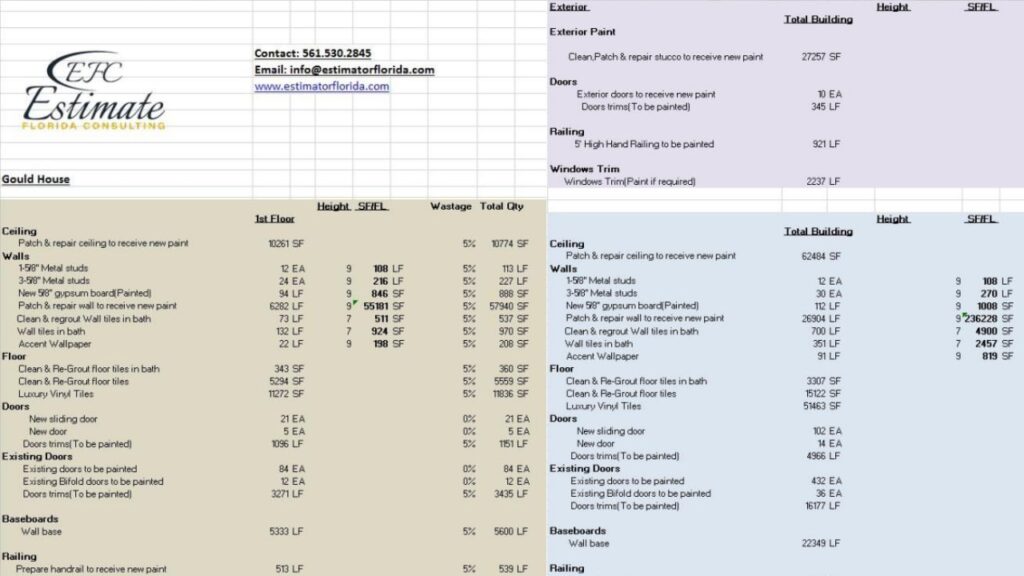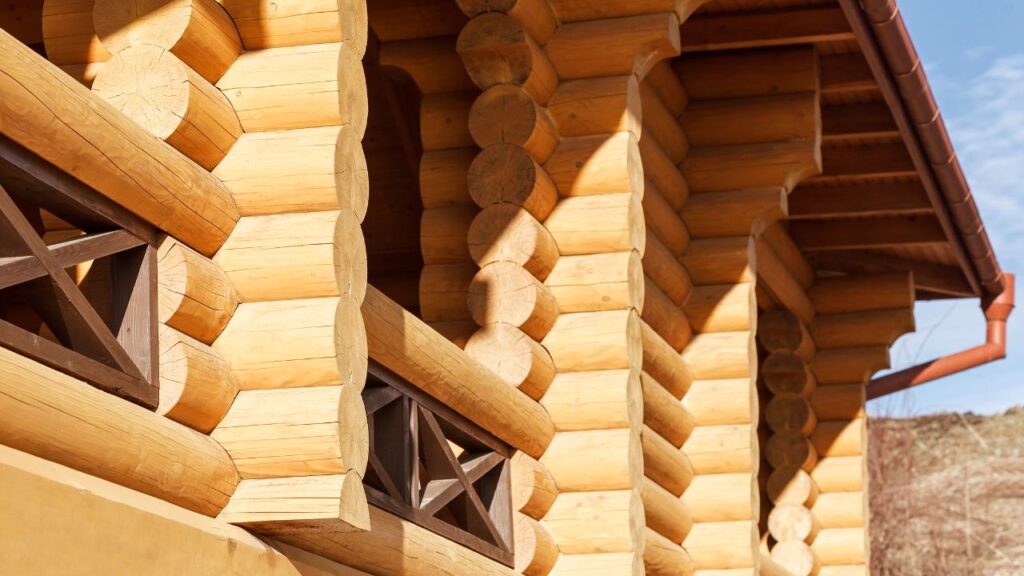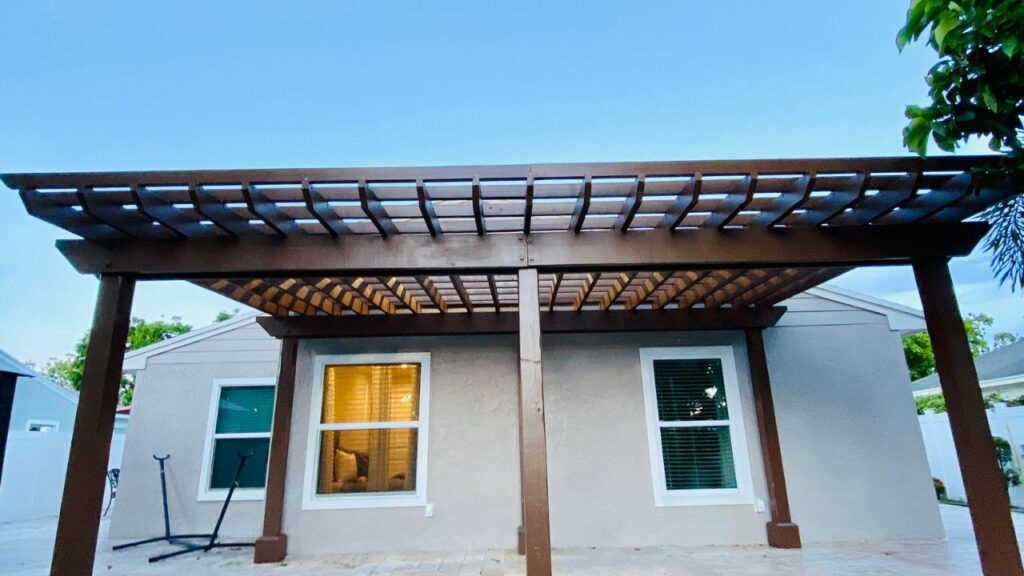Our Experience
- We provide estimates without any hassle.
- We have 30+ years of experience.
Lumber cost estimation in Doral holds distinct significance for both commercial and residential projects, each necessitating a nuanced approach. In commercial undertakings, which often entail expansive structures and heightened material requirements, meticulous lumber calculations serve as the cornerstone of maintaining budgetary precision. From skyscrapers that house businesses to warehouses that store goods, accurately assessing the amount and type of lumber needed is crucial to preventing unforeseen expenses and project delays.

In the realm of residential endeavors, the dynamics shift to encompass a delicate equilibrium between visual appeal and cost-effectiveness. For homes and housing complexes, the selection of lumber type and grade can substantially influence the final expenses. Opting for hardwoods might enhance the aesthetics of a residential structure but can lead to higher costs, while softwoods can provide economical solutions without compromising structural integrity.
In both commercial and residential contexts, the local market’s ebb and flow have a pivotal role in determining lumber costs. Doral’s unique economic landscape contributes to price fluctuations, necessitating a keen awareness of market trends to make accurate projections. Transportation costs, too, wield considerable influence, particularly for commercial ventures that require bulk shipments of lumber.
Ultimately, the art of lumber cost estimation in Doral encapsulates a multi-dimensional understanding of factors ranging from project size and purpose to lumber types, grades, and market dynamics. Both commercial and residential ventures thrive when armed with this knowledge, allowing stakeholders to make informed decisions that harmonize vision, budget, and execution, ensuring successful and financially prudent outcomes.
A keen understanding of the key influencers is indispensable. Delving into these factors enables both commercial and residential developers to make judicious decisions that align with their visions and budgets.
The very foundation of cost estimation hinges on the type of lumber chosen. Softwoods, like pine and cedar, present as more economically viable options, their abundance and rapid growth contributing to their affordability. In contrast, hardwoods such as oak or mahogany exude elegance but often come at a higher price due to their durability and visual allure. The nature of your project, be it a towering office complex or a cozy home, plays a pivotal role in dictating the appropriate lumber type that not only suits your functional requirements but also aligns with your aesthetic aspirations.
The quality spectrum of lumber, demarcated by grades ranging from construction-grade to high-quality appearance-grade, plays an instrumental role in the cost equation. Each grade embodies a distinct price point that mirrors the wood’s intrinsic quality and visual charm. Opting for a construction-grade might economize expenses but could compromise aesthetics, while selecting a premium appearance-grade could elevate the project’s allure while bearing a heftier price tag. The art lies in harmonizing your project’s functional needs with your financial capacities, navigating the grades to identify the sweet spot that augments both form and function.
Lumber prices waltz to the rhythm of market trends, a dance influenced by a myriad of external forces. The delicate balance of supply and demand, the pulsating heart of market dynamics, orchestrates price variations. Economic conditions and the pendulum of international trade further imbue the landscape with unpredictable cadences. To be a virtuoso in cost estimation, one must be a vigilant observer of these trends. Riding the currents of information on these shifting tides equips you to anticipate potential price fluctuations. Armed with foresight, you can proactively adjust your budget sails, ensuring your project steers clear of financial reefs.
The realm of lumber cost estimation extends beyond the mere selection of wood types and grades. It delves into the intricate art of quantification – an essential skill for both pragmatic budgeting and streamlined project execution.
Lumber, that cornerstone of construction, dances to the tune of measurement units known as board feet. This arcane term encapsulates the dimensions and thickness of the wood, transforming seemingly abstract numbers into tangible quantities. Mastery of this measurement alchemy is indispensable for accurate cost estimation. Converting the intricate language of inches and thicknesses into the universal dialect of board feet enables you to precisely gauge the wood needed for your project. This, in turn, empowers you to transmute these measurements into budgetary figures that are not only financially precise but also harmonious with the rhythmic flow of your endeavor.
In the tapestry of construction, waste is an inevitable thread woven into the fabric of creation. The artistry lies not in eliminating waste but in artfully accounting for it. This is where the virtuoso of cost estimation must wield their brush with care. Factoring in an additional percentage for waste isn’t just a precautionary measure; it’s a strategic one. This cushion ensures that your project isn’t blindsided by scarcity midway, saving you from the cacophony of delays and the expenses they entail. The prudent planner, aware of the capricious nature of construction, understands that overestimation is not a blight but a shield. A shield against unforeseen circumstances, a safeguard against resource depletion, and a testament to a foresightful vision that prioritizes preparedness over unwelcome surprises.
We help contractors find new customers with high-converting websites and locally targeted niche-specific lead-generation programs. You’ll never need to worry about running out of work again! We focus on quality over quantity with our leads for contractors.
When embarking on construction or woodworking projects, understanding the various lumber materials and their associated costs is crucial for effective planning. Here’s a comprehensive table outlining different types of lumber along with their estimated costs to assist you in making informed decisions:
Lumber Material | Description | Pros | Cons | Average Cost per Board Foot |
Pine | Softwood, easy to work with | Affordable, readily available | Less durable, prone to dents | $1.80 – $6.00 |
Cedar | Naturally resistant to decay and insects | Aromatic, durable, attractive | More expensive than some softwoods | $3.60 – $10.80 |
Redwood | Naturally resistant to rot and insects | Beautiful color, long-lasting | Limited availability, higher cost | $6.00 – $12.00 |
Oak | Hardwood, strong and durable | Attractive grain, versatile | Higher cost, can be difficult to work with | $4.80 – $14.40 |
Maple | Hardwood, fine texture and grain | Durable, finishes well | Relatively expensive, can be heavy | $4.80 – $12.00 |
Cherry | Hardwood, rich color and smooth grain | Elegant appearance, finishes beautifully | Expensive, may darken over time | $6.00 – $18.00 |
These cost estimates are approximate and can vary based on factors such as location, grade of lumber, and specific dimensions. Prices are given per board foot, which measures 1 inch thick, 12 inches wide, and 1 foot long. Consult lumber suppliers for accurate pricing based on your project requirements.
In the symphony of lumber cost estimation, the local notes carry distinct melodies, harmonizing with the unique dynamics of Doral’s economic landscape. A virtuoso in cost prediction recognizes that these local notes, expressed through price fluctuations and supplier nuances, are crucial movements in the composition of budgetary harmony.
Lumber prices are no monolith; they dance to the distinct rhythm of each locale. Doral, a dynamic canvas of commerce, is no exception. The pulse of lumber costs here is influenced by a medley of factors. The local supply, that heartbeat of availability, can sway prices depending on its ebb and flow. The cadence of demand, a symphony of project requirements, further modulates the tune. Even the caprices of weather, those capricious winds and relentless sunrays, can crescendo into price variations. To be a maestro of cost estimation in Doral is to comprehend this nuanced score. Researching historical price trends is a baton that conducts you through time, offering insights into the peaks and troughs, allowing you to anticipate the movements that await.
In the bustling marketplace of lumber, suppliers emerge as soloists, each wielding a unique melody in the cacophony of options. Doral’s stage hosts an array of suppliers, each composing their own price opus for the same lumber types and grades. The discerning ear of cost estimation comprehends that the symphony isn’t just about finding the cheapest note. Quality, like a resonating chord, resonates just as powerfully. Obtaining quotes from multiple suppliers unveils the orchestration of prices, allowing you to harmonize not only the monetary notes but also the quality crescendos. Remember, it’s not solely about finding the lowest cost but about finding the right cost that aligns with your project’s architectural harmony.

In the symphony of lumber cost estimation, the harmonious composition extends beyond the mere wood itself. The melodies of transportation and treatment play pivotal roles, each note adding layers of depth to the budgetary arrangement.
The journey of lumber from supplier to site is a narrative of its own, embellished with the notes of transportation costs. The distance between supplier and site is a compass guiding the cost calculation. Each mile traversed carries its own tune, influenced by the fuel cadences and vehicle maintenance harmonies. The transportation overture is also adorned with the crescendo of delivery fees. Some suppliers compose their own delivery choruses, while others prompt you to choreograph your own transportation ballet. Navigating this intricate melody requires not only a roadmap but a keen ear for evaluating the most cost-effective and efficient delivery path.
In the construction orchestra, some projects request a richer timbre than the raw wood notes can provide. This is where the embellishments of treatment and finishing come into play. Treated lumber, fortified against the elements, carries a unique price tag, a reflection of the protective layers woven around it. Finished lumber, its aesthetic grandeur enhanced by varnishes or stains, is also a costlier symphony than its raw counterpart. Evaluating whether your project resonates with these embellishments is key. Will the wood stand exposed to the elements, or does it seek shelter under a roof? Does its appearance warrant finishing, or does its role align more with functionality? The art lies in discerning these nuances and appending the appropriate costs to the symphony.
Wisdom prevails not only in deciphering the musical notes of expenses but also in conducting a symphony that harmonizes with prudence and preparation. Here, we unveil the two movements that stand as pillars of budgeting insight.
In the grand overture of cost estimation, the mantra is clear: let overestimation take center stage. While the temptation to lean towards optimism may be strong, the seasoned conductor knows that it’s better to allow the budgetary symphony to soar with a protective buffer. Overestimating the lumber costs functions as a guard against the capricious winds of unforeseen circumstances. The volatile dance of market prices, the unexpected crescendo of project scope changes, the unforeseen harmonies of weather conditions—all these notes can significantly influence the final cost composition. By embracing overestimation, you compose a budgetary melody that can gracefully navigate these unexpected cadences without falling out of tune.
Every symphony benefits from the expertise of a seasoned conductor, and the realm of lumber cost estimation is no different. If the woodlands of uncertainty cast shadows over your project’s cost landscape, seek the guiding baton of professionals. Architects, those architects of structure and vision, bring their calculated insights to the composition. Contractors, those crafters of execution, weave their practical wisdom into the notes. Lumber experts, those virtuosos of wood, lend their insights into the selection of the right timber for the right purpose. Like harmonious sections of an orchestra, these professionals harmonize their expertise, ensuring your cost composition rings true to the harmonies of both precision and practicality.
The selection of materials takes on the role of a conductor assembling an orchestra, harmonizing various elements to compose the final opus. Here, we delve into the world of diverse wood types and engineered alternatives, each contributing their unique notes to the symphony of construction.

The melody of choosing between softwood and hardwood is one of nuance and necessity, akin to selecting different instruments for a musical ensemble. Softwood, with its affordability and widespread availability, often takes the lead in projects where economy is a fundamental note. It becomes the rhythmic hum of residential structures, gracefully framing walls and providing vital support to roofs. On the other hand, hardwood enters the composition as a crescendo of durability and aesthetics. Its robust notes resonate with structures that aspire to both longevity and visual allure. From the elegant resonance of hardwood flooring to the intricate harmonies of fine furniture, hardwoods introduce an essence of luxury into functional design. The artistry lies in the orchestration of your project’s composition—does it call for the rhythmic hum of economy or the resonant elegance of hardwood? By prioritizing based on these distinct demands, you curate a wood ensemble that harmonizes purpose with aesthetics, crafting a symphony that resonates in every corner.
In the symphony of construction, the musical repertoire extends beyond the traditional timbres of natural wood, embracing the engineered crescendos of plywood and particleboard. These alternatives, akin to a harmonious duet, introduce cost-effectiveness into the composition without compromising structural integrity. Plywood, with its intricate layers, plays the role of an instrument with a balanced timbre, delivering a harmonious blend of strength and flexibility. On the other hand, particleboard, composed of wood particles bound together, enters the symphony with its unique resonance.

In the symphony of construction, the musical repertoire extends beyond the traditional timbres of natural wood, embracing the engineered crescendos of plywood and particleboard. These alternatives, akin to a harmonious duet, introduce cost-effectiveness into the composition without compromising structural integrity. Plywood, with its intricate layers, plays the role of an instrument with a balanced timbre, delivering a harmonious blend of strength and flexibility. On the other hand, particleboard, composed of wood particles bound together, enters the symphony with its unique resonance. It finds its voice in specific applications, such as cabinetry and shelving, providing a solo performance that enhances efficiency and utility within the larger composition. These materials, much like instrumental solos, grant you the ability to allocate the precise wood type for the specific task within the architectural symphony. Their cost-effective nature takes center stage, particularly in the grand movements of more extensive structures where efficiency becomes the principal conductor.
Maximize your Lumber business’s potential with our competitive financing options

In the orchestration of a construction project, a pivotal decision awaits: to embark on a DIY journey or to entrust the symphony to professional conductors. This choice is not just about crafting a project but about orchestrating it with precision and finesse. Here, we explore the intricate duet between personal endeavor and professional expertise.
The first movement in this musical dilemma is a reflection of your skill and experience. The novice musician might find the allure of playing all the instruments irresistible, believing that a solo performance saves both time and resources. However, just as an inexperienced pianist can hit discordant notes, the inexperienced builder can introduce costly mistakes. The skilled conductor, aware of their limitations, acknowledges that some instruments require virtuosos. Consider your aptitude for the complexities of construction. While DIY might initially seem cost-effective, it’s a composition riddled with risk. Missteps could result in a cacophony of additional expenses, derailing the harmony of the project.
The artistry of choosing between DIY and professional services involves more than the initial monetary notes. The composition extends to encompass the hidden harmonies of time and effort. The DIY route demands hours of rehearsal, navigating not only the technical aspects but also the choreography of construction. Time spent on learning and rectifying errors is time not invested elsewhere. The project’s tempo might falter, leading to lost opportunities and postponed outcomes. Conversely, the professional conductor, attuned to the rhythm, can craft a symphony of efficient and accurate execution. This conductor has honed their craft, saving not just time but also preventing errors that can crescendo into costly complications.
The resounding chords of sustainability and responsible lumber sourcing create a vital harmony that echoes the collective call for environmental stewardship. In this movement, we delve into the intricate harmonies of eco-friendly options and the enduring echoes of long-term impact.
As the global chorus of environmental consciousness swells, the selection of lumber materials transforms into an ethereal art. Opting for wood that is sustainably and responsibly sourced orchestrates a melodious convergence with the green movements, whose purpose is to safeguard our planet’s intricate tunes. Certifications like the Forest Stewardship Council (FSC) emerge as the notes of harmony, signifying that the wood’s origin traces back to meticulously managed forests. These woodlands, akin to sanctuaries of nature’s music, ensure the perpetual nurturing of our precious ecosystem. The virtuoso of cost estimation recognizes that these considerations are no longer mere options, but an integral part of the very composition. By selecting materials that resonate with eco-friendly principles, you extend your project’s impact beyond the confines of its physical structure, contributing harmoniously to the symphony of global preservation.
While the initial cadences of budgeting compose the opening verses of construction, the sagacious conductor extends their gaze to the distant horizon of time. The resonances of choices, akin to an echoing refrain, resonate through the years. The allure of budget-friendly options might initially captivate like an enchanting crescendo, yet the cost estimation maestro discerns the intricacies. Investing in quality lumber, despite its higher initial costs, lays the foundation for harmonious longevity. The robustness of painstakingly crafted wood, the endurance of refined materials—these harmonies resound with the notes of fewer replacements, diminished repairs, and mitigated maintenance. The currency saved over the expanse of time, much like a mellifluous coda, stands as a testament to the sagacity that bridges both the immediate and the enduring.

Looking for a reliable construction equipment rental company? Look no further. Rent from us today.
The future notes of lumber costs emerge as a composition woven with both uncertainty and opportunity. Here, we delve into the echoes of predicted trends and the harmonies of strategies crafted to navigate them.
Recent years have seen the lumber market swaying to a rhythm of volatility. The price fluctuations, akin to an unpredictable melody, have kept developers and builders poised for action. Yet, to master the art of cost estimation, the maestro must shift their focus beyond the present cadence, gazing into the crystal ball of industry forecasts. These forecasts, reminiscent of intricate musical scores, offer glimpses into potential trends. Will the market crescendo with soaring prices, or will the harmonies of affordability linger a while longer? Attuning your ear to these predictions equips you with the ability to adjust the rhythm of your budget with foresight. Anticipating these potential price trends mirrors the role of a conductor, leading a symphony with prescient insight, ensuring that your budget’s harmonies remain in tune even amid the discord of market fluctuations.
As the conductor of cost estimation, your role transcends perception; it extends to the orchestration of strategies that gracefully navigate the notes of uncertainty. In the realm of lumber costs, the score often includes sudden, unexpected crescendos in prices. To counter these staccato interruptions, the maestro employs strategies of mitigation. Diversifying your sources of lumber is akin to assembling a reserve section of musicians. When one instrument falters, another seamlessly steps in, ensuring the symphony’s continuity. Similarly, considering alternative materials—akin to weaving brass harmonies when strings are scarce—introduces a layer of flexibility. These strategies, like interwoven melodies, harmonize to create a composition that maintains equilibrium despite abrupt price fluctuations. Just as a well-conducted orchestra adapts to unforeseen changes, the adept cost estimator adjusts the rhythm of the budget without missing a beat.
In the grand finale of estimating lumber costs in the vibrant city of Doral, the symphony of construction embraces a culmination of wisdom and insight. Navigating the complexities of pricing demands a harmonious understanding of the myriad factors that entwine to shape the financial composition. As the curtain draws, we reflect upon the melodies of lumber types, the harmonies of grades, the tempo of market trends, and the resonances of additional expenses—each contributing their distinct timbre to the symphony of budgeting.
In this intricate composition, the choice of lumber types beckons the selection of instruments for an artistic performance. Softwood and hardwood dance to their unique rhythms, offering the choice between economical cadences and the resounding crescendos of aesthetics and durability. The grades of lumber, akin to musical notes on a scale, harmonize to form a symphonic arrangement of quality and visual appeal, guiding your hand in composing a melodious project.
Hardwood is generally more expensive due to its durability and aesthetics, but specific costs depend on the type and grade of wood.
It’s advisable to create a buffer in your budget to accommodate potential price increases.
Opting for sustainable lumber aligns with environmental considerations and may have long-term benefits, despite higher initial costs.






Here I am going to share some steps to get your residential and commercial lumber cost estimate report.
You can send us your plan on info@estimatorflorida.com
Before starting your project, we send you a quote for your service. That quote will have detailed information about your project. Here you will get information about the size, difficulty, complexity and bid date when determining pricing.
We do residential and commercial lumber cost estimating and prepare a detailed report for your project. At last, you finalize the report and finish the project.



This trendy outdoor shopping and dining destination boasts a mix of local boutiques and well-known brands. You can find unique fashion pieces, accessories, and gifts while exploring the charming streets of Downtown Doral. After shopping, you can indulge in a variety of cuisines, from Latin American flavors to Asian fusion, at the diverse selection of restaurants and cafes.
Immerse yourself in the rich cultural heritage of Doral through thought-provoking art exhibits and engaging historical displays. The museum hosts rotating art exhibitions featuring local and regional artists, as well as permanent exhibits that tell the story of Doral’s growth and development over the years.
Doral Golf Resort & Spa – The Blue Monster
Apart from the luxurious golf courses, the Doral Golf Resort & Spa boasts the famous “Blue Monster” golf course. Known for its challenging layout and signature water hazards, it has hosted numerous prestigious golf tournaments. Even if you’re not a golfer, witnessing the grandeur of the Blue Monster is an unforgettable experience.
Doral Meadows Park is a beautifully landscaped green space with a picturesque lake at its center. The park offers walking trails, fishing opportunities, and open fields for picnics and recreational activities. It’s an ideal spot for spending quality time with family and friends amidst nature’s beauty.
561-530-2845
info@estimatorflorida.com
Address
5245 Wiles Rd Apt 3-102 St. Pete Beach, FL 33073 United States
561-530-2845
info@estimatorflorida.com
Address
5245 Wiles Rd Apt 3-102 St. Pete Beach, FL 33073 United States
All copyright © Reserved | Designed By V Marketing Media | Disclaimer
IMPORTANT: Make sure the email and cell phone number you enter are correct. We will email and text you a link to get started.
By clicking “I Agree” above you give Estimate Florida Consultin express written consent to deliver or cause to be delivered calls and messages to you by email, telephone, pre-recorded message, autodialer, and text. Message and data rates may apply. You are able to opt-out at any time. You can text STOP to cancel future text messages.
